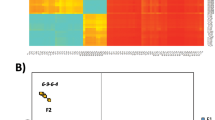Abstract
Mitochondrial DNA (mtDNA) of Mytilus trossulus from the Gulf of Gdansk (southern Baltic) and M. edulis from Swansea Bay, South Wales, UK, collected in 1991, was studied by restriction-enzyme analysis. These two species were more similar to each other in haplotype frequencies than either was to M. galloprovincialis from Britain. M. trossulus resembles M. edulis in having a high frequency of heteroplasmy restricted to males. However, in contrast to M. edulis where restriction-site heteroplasmy predominates, in M. trossulus heteroplasmic individuals possess two genomes which differ in length by up to 3 kilobases.
Similar content being viewed by others
References
Avise JC (1989) Gene trees and organismal histories: a phylogenetic approach to population biology. Evolution 43:1192–1208
Biju-Duval C, Ennafa H, Dennebouy N, Monnenot M, Mignotte F, Soriguer RC, EI Gaaied A, EI Hili A, Mounolou JC (1991) Mitochondrial DNA evolution in lagomorphs: origin of systematic heteroplasmy and organization of diversity in European rabbits. J molec Evolut 33:92–102
Blot M, Legendre B, Albert P (1990) Restriction fragment length polymorphism of mitochondrial DNA in subantarctic mussels. J exp mar Biol Ecol 141:79–86
Bulnheim HP, Gosling E (1988) Population genetic structure of mussels from the Baltic Sea. Helgoländer Meeresunters 42: 113–129
Edwards CA, Skibinski DOF (1987) Genetic variation of mitochondrial DNA in mussel (Mytilus edulis and M. galloprovincialis) populations from South West England and South Wales. Mar Biol 94:547–556
Fisher C, Skibinski DOF (1990) Sex-biased mitochondrial DNA heteroplasmy in the marine mussel Mytilus. Proc R Soc (Ser B) 242:149–156
Geller JB, Carlton JT, Powers DA (1993) Interspecific and intrapopulation variation in mitochondrial ribosomal DNA sequences of Mytillus spp. (Bivalvia; Mollusca). Molec mar Biol Biotechnol 2:44–50
Hayasaka K, Toshida T, Horai S (1991) Heteroplasmy and polymorphism in the major noncoding region of mitochondrial DNA in Japanese monkeys: association with tandemly repeated sequences. Molec Biol Evolut 8:399–415
Hoeh WR, Blakley KH, Brown WM (1991) Heteroplasmy suggests limited biparental inheritance of Mytilus mitochondrial DNA. Science, NY 251:1488–1490
Hoelzel AR, Hancock JM, Dover GA (1993) Generation of VNTR's and heteroplasmy by sequence turnover in the mitochondrial control region of two elephant seal species. J molec Evolut 37:190–197
Kondo R, Satta Y, Matsuura ET, Ishiwa H, Takahata N, Chigusa SI (1990) Incomplete maternal transmission of mitochondrial DNA in Drosophila. Genetics, Austin, Tex 126:657–663
Longo FJ, Anderson E (1969) Cytological aspects of fertilization in the lamellibranch, Mytilus edulis. II. Development of the male pronucleus and the association of the maternally and paternally derived chromosomes. J exp Zool 172:97–120
Magoulas A, Zouros E (1993) Restriction site heterplasmy in anchovy (Engraulis encrasicolus) indicates incidental biparental inheritance of mitochondrial DNA. Molec Biol Evolut 10:319–325
Matsuura ET, Fukuda H, Chigusa SI (1991a) Mitochondrial DNA heteroplasmy maintained in natural populations of Drosophila simulans in Reunion. Genet Res 57:123–126
Matsuura ET, Niki Y, Chigusa SI (1991b) Selective transmission of mitochondrial DNA heteroplasmic lines for intra- and interspecific combinations in Drosophila melanogaster. Jap J Genet 66:197–207
Nei M. (1972) Genetic distance between populations. Am Nat 106: 283–292
Rand DM (1993) Endotherms, ectotherms and mitochondrial genome-size variation. J molec Evolut 37:281–295
Roff DA, Bentzen P (1989) The statistical analysis of mitochondrial DNA polymorphisms: χ2 and the problem of small samples. Molec Biol Evolut 6:539–545
Skibinski DOF, Beardmore JA, Cross TF (1983) Aspects of population genetics of Mytilus (Mytilidae; Mollusca) in the British Isles. Biol J Linn Soc 19:137–183
Skibinski DOF, Gallagher C, Beynon CM (1994) Mitochondrial DNA inheritance. Nature, Lond 368:817–818
Vainola R, Hvilsom MM (1991) Genetic divergence and a hybrid zone between Baltic and North Sea Mytilus populations (Mytilidae: Mollusca). Biol J Linn Soc 43:127–148
Wallis GP (1987) Mitochondrial DNA insertion polymorphism and germ line heteroplasmy in the Triturus cristatus complex. Heredity, Lond 58:229–238
Zouros E, Ball AO, Saavedra C, Freeman KR (1994) Mitochondrial DNA inheritance. Nature, Lond 368:p. 818
Zouros E, Freeman KR, Ball AO, Pogson GH (1992) Direct evidence for extensive paternal mitochondrial DNA inheritance in the marine mussel Mytilus. Nature, Lond 359:412–414
Author information
Authors and Affiliations
Additional information
Communicated by J. Mauchline, Oban
Rights and permissions
About this article
Cite this article
Wenne, R., Skibinski, D.O.F. Mitochondrial DNA heteroplasmy in European populations of the mussel Mytilus trossulus . Marine Biology 122, 619–624 (1995). https://doi.org/10.1007/BF00350683
Received:
Accepted:
Issue Date:
DOI: https://doi.org/10.1007/BF00350683



